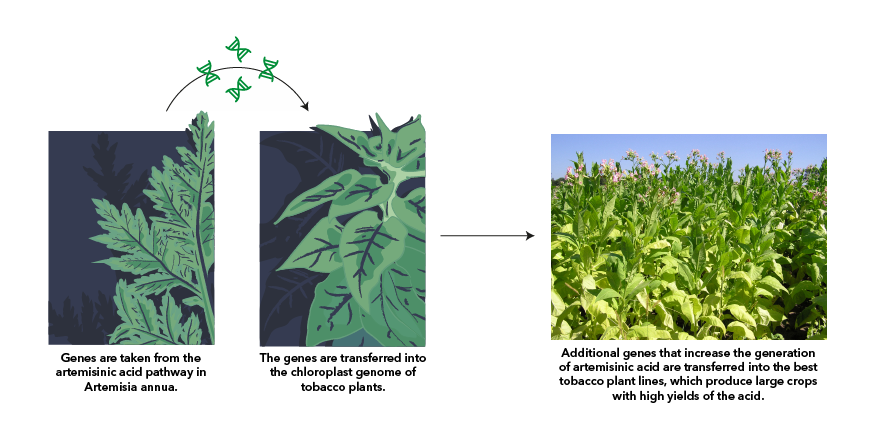Germany
June 14, 2016
A new and inexpensive technique for mass-producing the main ingredient in the most effective treatment for malaria, artemisinin, could help meet global demands for the drug, according to a study to be published in the journal eLife.
Artemisinin is produced in low yields by a herb called Artemisia annua (A. annua), otherwise known as sweet wormwood. Researchers from the Max Planck Institute of Molecular Plant Physiology have now discovered a new way to produce artemisinic acid, the molecule from which artemisinin is derived, in high yields. Their method involves transferring its metabolic pathway – the series of biochemical steps involved in its production – from A. annua into tobacco, a high-biomass crop.
“Malaria is a devastating tropical disease that kills almost half a million people every year,” says contributing author Ralph Bock, Director of the Department for Organelle Biology, Biotechnology and Molecular Ecophysiology.
“For the foreseeable future, artemisinin will be the most powerful weapon in the battle against malaria but, due to its extraction from low-yielding plants, it is currently too expensive to be widely accessible to patients in poorer countries. Producing artemisinic acid in a crop such as tobacco, which yields large amounts of leafy biomass, could provide a sustainable and inexpensive source of the drug, making it more readily available for those who need it most.”
The team has called this approach to producing more artemisinic acid COSTREL (“combinatorial supertransformation of transplastomic recipient lines”). The first step in their process was to transfer the genes of the artemisinic acid pathway’s core set of enzymes into the chloroplast genome of tobacco plants, generating what are known as transplastomic plants.
The team then used their best transplastomic tobacco plant line to introduce an additional set of genes into its nuclear genome, generating the COSTREL lines. These remaining genes encode factors that increase the synthesis, or generation, of the acid in ways that are still largely unknown.

New methods in plant biotechnology could allow an inexpensive mass-production of a malaria drug. Transfering genes from Artemisisa annua to tobacco leads to a high-yielding production of the naturally occuring artemisinic acid. - © Fuentes et al., eLife
“While the artemisinic acid pathway in A. annua is confined to the glandular hairs on the plant, leading to low yields of artemisinin, our COSTREL tobacco lines produce it in their chloroplasts and therefore the whole leaf,” says lead author and postdoctoral researcher Paulina Fuentes.
“We generated over 600 engineered tobacco plant lines that harbour different combinations of these additional genes, and analysed them in terms of the amounts of artemisinic compounds they acquired. We could then identify those that generated unprecedented levels of 120 milligrams per kilogram of artemisinic acid in their leaves, which can be readily converted into artemisinin through simple chemical reactions.”
Although further increases in these production levels will be needed if global demand for artemisinin is to be met, the study lays the foundation for much cheaper production of this life-saving therapy in a high-biomass crop, in contrast to a single medicinal plant.
It also provides a new tool for engineering many other complex pathways, with the potential to increase production of other essential therapeutic ingredients.
About eLife
eLife is a unique collaboration between the funders and practitioners of research to improve the way important research is selected, presented, and shared. eLife publishes outstanding works across the life sciences and biomedicine — from basic biological research to applied, translational, and clinical studies. All papers are selected by active scientists in the research community. Decisions and responses are agreed by the reviewers and consolidated by the Reviewing Editor into a single, clear set of instructions for authors, removing the need for laborious cycles of revision and allowing authors to publish their findings quickly. eLife is supported by the Howard Hughes Medical Institute, the Max Planck Society, and the Wellcome Trust. Learn more at elifesciences.org.